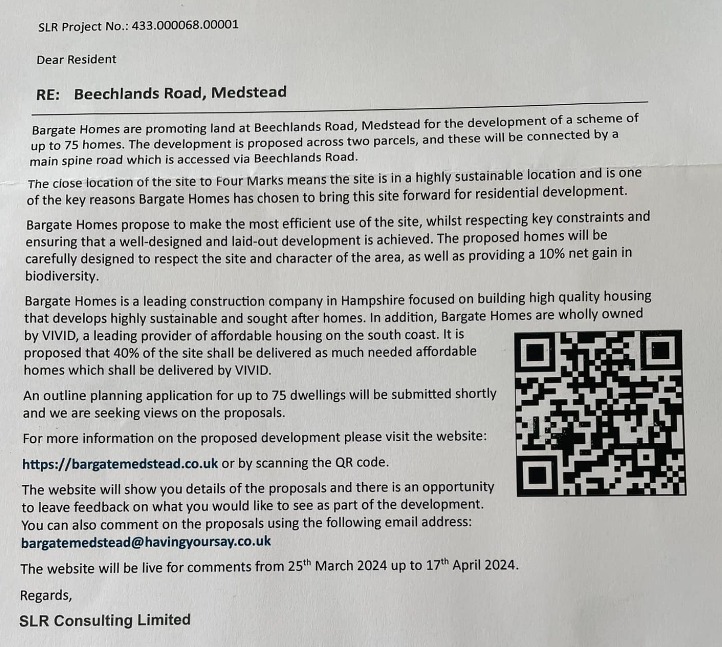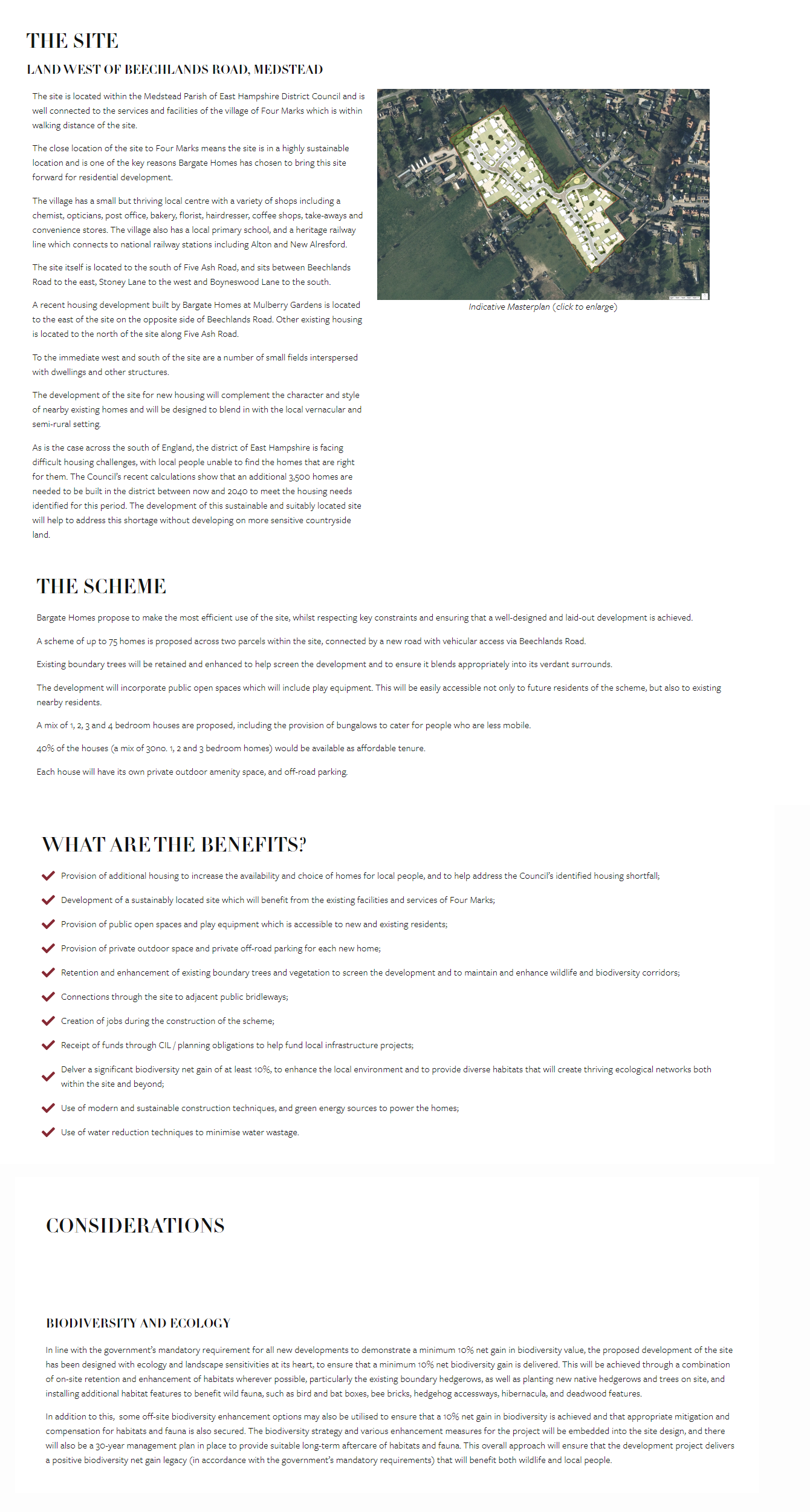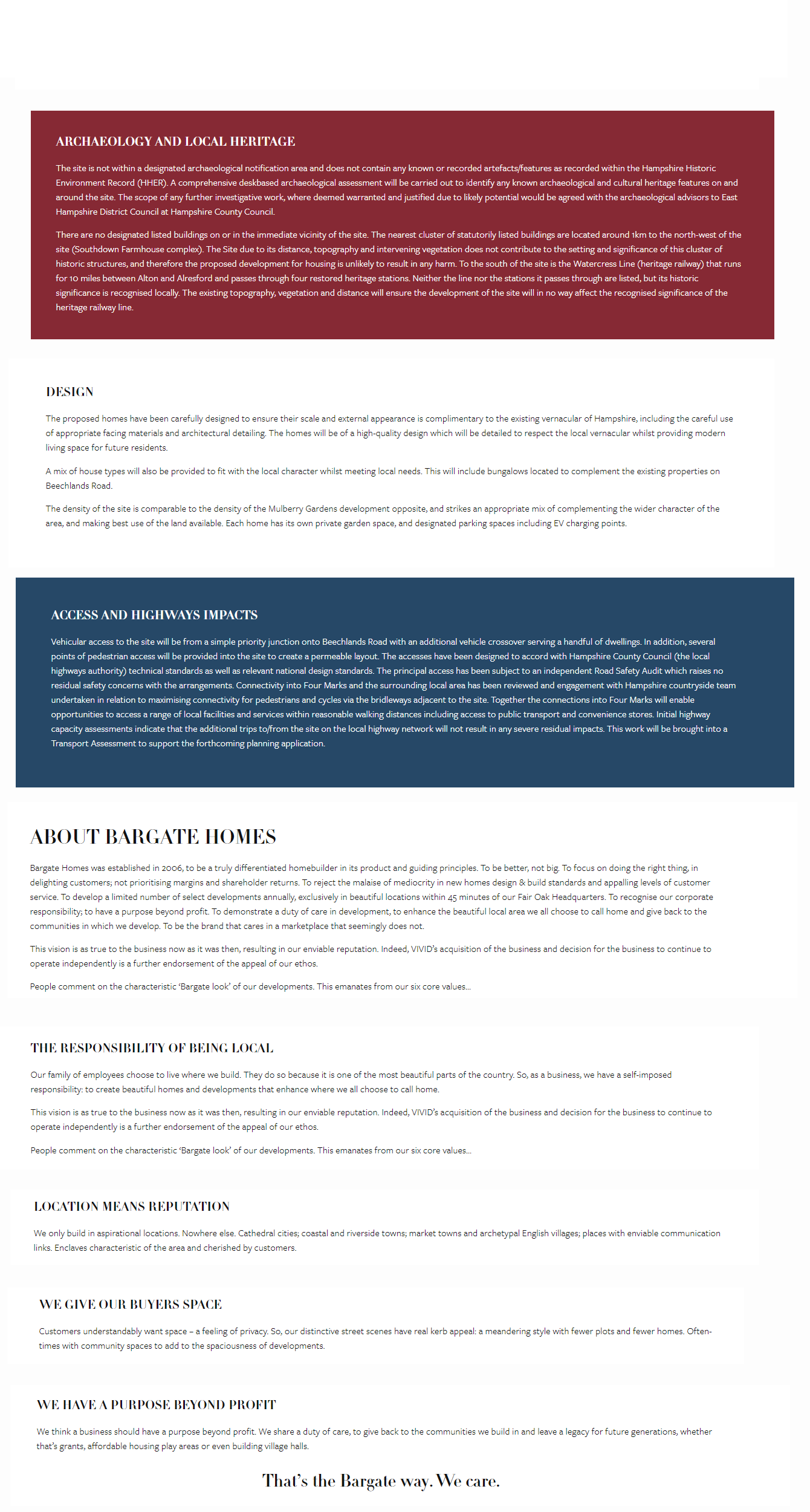🧾 The context:
Before submitting its outline application for 75 dwellings on Beechlands Road, Bargate Homes (via SLR Consulting Limited) distributed a public letter to residents in Medstead. The letter invited comments on a developer-hosted website (https://bargatemedstead.co.uk) and email (bargatemedstead@havingyoursay.co.uk), and made no reference to the future statutory consultation process through East Hampshire District Council (EHDC).

The letter:
- Referred to the site as being in a “highly sustainable location”,
- Presented the development as already in motion,
- Offered no planning context (e.g. tilted balance, policy conflict, settlement boundaries),
- Was worded in sales-like language, rather than balanced or informative terms.
This letter reached residents before EHDC opened its formal consultation window — and risked influencing public perception and suppressing formal objections.
The developer website:
The letter directed residents to a dedicated website (https://bargatemedstead.co.uk), which reinforced the same tone through promotional, emotionally charged, and brand-building language. This website included several statements that should not have appeared in a lawful, balanced consultation, such as:
- “That’s the Bargate way – we care.”
- “Bargate is a locally based developer who has won awards for the quality of our homes and developments.”
- “We have built a reputation for high-quality homes in well-connected locations, delivering public open space and enhancing biodiversity.”
- “Our vision for this new neighbourhood will respect the character of the local area.”
- “We care about our legacy and strive to create places that future generations will be proud of.”
These statements:
- Were not supported by objective or site-specific evidence
- Deflected attention from policy constraints or material planning risks
- Romanticised the development while omitting adverse impacts or legal context
📌 Critically, this promotional tone stood in stark contrast to the planning reality. The application sought permission under Paragraph 11(d) of the National Planning Policy Framework (NPPF) — the so-called tilted balance, which only applies where local policies are out of date. This means that the proposal:
- Conflicted with the adopted Local Plan
- Lay outside the settlement policy boundary
- Could only be approved if its benefits significantly and demonstrably outweighed its harms
➡️ The website made no mention of these legal tests or constraints, instead presenting the development as inevitable, desirable, and uncontroversial — potentially misleading residents who did not understand the planning system.
🧩 Why this is a potential ground for Judicial Review:
⚖️ 1. Procedural Unfairness – Misinformation Prior to Statutory Consultation
While early engagement by developers is encouraged by NPPF Paragraph 132, it must be proactive, transparent, and enable fair participation.
This letter presented the scheme as if it were already legitimate or desirable, and omitted material facts that residents would have needed to assess the proposal intelligently. By doing so before EHDC’s consultation opened, it may have distorted public understanding, especially among older or less digitally confident residents.
⚖️ 2. Confusion and Imbalance – Closed-Loop Feedback
Directing residents to a private platform — controlled by the developer — risks creating a closed loop of feedback, in which only favourable or filtered responses are recorded. If EHDC later accepted this material as evidence of community views, it would distort the balance of representation in the planning record.
This creates a risk that public objections were diluted or pre-empted — and that the planning file does not reflect an impartial consultation.
⚖️ 3. Procedural Impropriety – Council’s Duty to Safeguard Public Participation
If EHDC was aware that developer-led communications had already been distributed, it had a responsibility to issue clear guidance explaining the difference between pre-application engagement and the formal statutory process.
Failure to correct or clarify such confusion could amount to procedural omission, contributing to public disadvantage and erosion of trust in the planning process.
🔍 Summary:
If a developer initiates public engagement before submitting an application, they have a duty to do so in a transparent, honest, and balanced manner.
If that engagement:
- Presents the proposal as inevitable,
- Omits material policy context,
- Discourages formal participation, or
- Channels feedback through private, unaccountable platforms,
👉 Then the consultation process as a whole may be procedurally flawed, and the planning decision based on it legally challengeable through Judicial Review.
The combination of misleading pre-application messaging and a failure by the local authority to intervene can result in a breach of lawful consultation standards, undermining both the legitimacy of public engagement and the transparency required under planning law.
✅ Supporting Law and Policy:
NPPF Paragraph 132:
Applicants should work closely with those affected by their proposals to evolve designs that take account of the views of the community.
➤ Why it matters: Consultation must empower, not mislead, the public.
Gunning Principles (R v Brent LBC, 1985):
Requires adequate information, time, and responsiveness.
➤ Why it matters: Bargate’s letter arguably failed to provide sufficient or impartial information for a fair process.
R (Moseley) v Haringey LBC [2014] UKSC 56:
Consultation must include information about the arguments for and against a proposal.
➤ Why it matters: The letter presented only the benefits, with no reference to constraints or opposition grounds.


